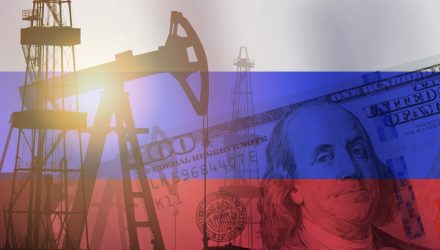Energy-related exchange traded funds climbed on Monday, with crude oil prices hitting their highest level since 2008, as Western countries considered a Russia oil ban and a hiccup in the Iran nuclear deal added another layer of supply uncertainty.
Among the best-performing non-leveraged ETFs on Monday, the SPDR Oil & Gas Equipment & Services ETF (NYSEArca: XES) advanced 7.9%, the VanEck Vectors Oil Service ETF (NYSEArca: OIH) gained 8.2%, and the iShares U.S. Oil Equipment & Services ETF (NYSEArca: IEZ) increased 7.3%. The broader Energy Select Sector SPDR (NYSEArca: XLE), the largest equity-based energy exchange traded fund, was up 1.0%.
Meanwhile, the United States Oil Fund (NYSEArca: USO), which tracks West Texas Intermediate crude oil futures, and the United States Brent Oil Fund (NYSEArca: BNO), which tracks Brent crude oil futures, were up 4.6% and 6.0%, respectively. WTI crude oil futures were up 4.7% to $121.2 per barrel, and Brent crude gained 6.3% to $125.6 per barrel.
WTI crude oil futures briefly crossed over $130 per barrel, and Brent hit $139 per barrel earlier in the day, their highest level since July 2008.
“The original spikes were on embargo worries, but then a lot of countries came out and said they won’t do it,” Bob Yawger, director of energy futures at Mizuho, told Reuters. “Western European countries are not in a position to embargo, and that’s why markets are lower now as people are starting to realize it.”
Crude oil prices have surged about 60% since the start of 2022, with the recent jump beginning to fuel fears of slowing global economic growth and rising inflation, or a so-called stagflation environment.
The latest rally in the oil markets was attributed to U.S. Secretary of State Antony Blinken revealing on Sunday that the United States and European allies could explore banning imports of Russian oil.
“We consider $125 per barrel, our near-term forecast for Brent crude oil, as a soft cap for prices, although prices could rise even higher should disruptions worsen or continue for a longer period,” UBS commodity analyst Giovanni Staunovo told Reuters, adding that a prolonged war could push Brent above $150 per barrel.
Analysts at Bank of America warned that if most of Russia’s oil exports were cut from global markets, it could equate to a five million barrels per day shortfall in supply or more, which could help bring prices up to $200 per barrel. JPMorgan analysts projected that oil could hit $185 this year, and analysts at Mitsubishi UFJ Financial Group Inc. calculated that crude may reach $180 and contribute to a global recession.
Meanwhile, Iran’s oil supply outlook was also put into question after nuclear deal talks fell through. Russia demanded guarantees that the sanctions it was facing over the Ukraine conflict would not impede trade with Tehran, and China also raised new demands.
For more news, information, and strategy, visit the Alternatives Channel.








